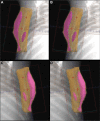Intensity-modulated radiation therapy for early-stage breast cancer: is it ready for prime time?
- PMID: 28360536
- PMCID: PMC5365280
- DOI: 10.2147/BCTT.S127583
Intensity-modulated radiation therapy for early-stage breast cancer: is it ready for prime time?
Abstract
Whole breast external beam radiotherapy (WBEBRT) is commonly used as an essential arm in the treatment management of women with early-stage breast cancer. Dosimetry planning for conventional WBEBRT typically involves a pair of tangential fields. Advancement in radiation technology and techniques has the potential to improve treatment outcomes with clinically meaningful long-term benefits. However, this advancement must be balanced with safety and improved efficacy. Intensity-modulated radiation therapy (IMRT) is an advanced technique that shows promise in improving the planning process and radiation delivery. Early data on utilizing IMRT for WBEBRT demonstrate more homogenous dose distribution with reduction in organs at risk doses. This translates to toxicities reduction. The two common descriptors for IMRT are forward-planning "fields in field" and inverse planning. Unlike IMRT for other organs, the aim of IMRT for breast planning is to achieve dose homogeneity and not organ conformality. The aim of this paper was to evaluate whether IMRT is ready for prime time based on these three points: 1) workload impact, 2) the clinical impact on the patient's quality of life, and 3) the appropriateness and applicability to clinical practice.
Keywords: clinical practice; early-stage breast cancer; intensity-modulated radiation therapy; quality of life; radiotherapy; workload impact.
Conflict of interest statement
Disclosure The authors report no funding sources and no conflicts of interest in this work.
Figures
Similar articles
-
[Dosimetric evaluation of intensity-modulated tangential beam versus conventional tangential irradiation for breast cancer].Ai Zheng. 2006 Jul;25(7):855-60. Ai Zheng. 2006. PMID: 16831277 Chinese.
-
Intensity modulation to improve dose uniformity with tangential breast radiotherapy: initial clinical experience.Int J Radiat Oncol Biol Phys. 2000 Dec 1;48(5):1559-68. doi: 10.1016/s0360-3016(00)01396-1. Int J Radiat Oncol Biol Phys. 2000. PMID: 11121662
-
Left breast irradiation with tangential intensity modulated radiotherapy (t-IMRT) versus tangential volumetric modulated arc therapy (t-VMAT): trade-offs between secondary cancer induction risk and optimal target coverage.Radiat Oncol. 2019 Sep 2;14(1):156. doi: 10.1186/s13014-019-1363-4. Radiat Oncol. 2019. PMID: 31477165 Free PMC article.
-
Intensity-modulated radiotherapy: current status and issues of interest.Int J Radiat Oncol Biol Phys. 2001 Nov 15;51(4):880-914. doi: 10.1016/s0360-3016(01)01749-7. Int J Radiat Oncol Biol Phys. 2001. PMID: 11704310 Review.
-
Intensity-modulated radiation therapy for breast: is it for everyone?Semin Radiat Oncol. 2011 Jan;21(1):51-4. doi: 10.1016/j.semradonc.2010.08.009. Semin Radiat Oncol. 2011. PMID: 21134654 Review.
Cited by
-
Case Report: Chagas Disease in a Traveler Who Developed Esophageal Involvement Decades after Acute Infection.Am J Trop Med Hyg. 2023 Jan 16;108(3):543-547. doi: 10.4269/ajtmh.22-0461. Print 2023 Mar 1. Am J Trop Med Hyg. 2023. PMID: 36646072 Free PMC article.
-
Dosimetric comparison between three- and four-dimensional computerised tomography radiotherapy for breast cancer.Oncol Lett. 2019 Aug;18(2):1800-1814. doi: 10.3892/ol.2019.10467. Epub 2019 Jun 12. Oncol Lett. 2019. PMID: 31423248 Free PMC article.
-
Assessment of Field-in-Field, 3-Field, and 4-Field Treatment Planning Methods for Radiotherapy of Gastro-Esophageal Junction Cancer.J Biomed Phys Eng. 2022 Oct 1;12(5):439-454. doi: 10.31661/jbpe.v0i0.2206-1500. eCollection 2022 Oct. J Biomed Phys Eng. 2022. PMID: 36313414 Free PMC article.
-
Two-Level Factorial Pre-TomoBreast Pilot Study of Tomotherapy and Conventional Radiotherapy in Breast Cancer: Post Hoc Utility of a Mean Absolute Dose Deviation Penalty Score.Technol Cancer Res Treat. 2020 Jan-Dec;19:1533033820947759. doi: 10.1177/1533033820947759. Technol Cancer Res Treat. 2020. PMID: 32940569 Free PMC article.
-
Impact of patient and treatment characteristics on heart and lung dose in adjuvant radiotherapy for left-sided breast cancer.Radiat Oncol. 2019 Aug 28;14(1):153. doi: 10.1186/s13014-019-1364-3. Radiat Oncol. 2019. PMID: 31462267 Free PMC article.
References
-
- WHO Fact Sheets by Cancer. [Accessed April 12, 2016]. Available from: http://globocan.iarc.fr/Pages/fact_sheets_cancer.aspx.
-
- American Cancer Society Radiation for Breast Cancer. 2016. [Accessed November 7, 2016]. Available from: http://www.cancer.org/cancer/breastcancer/detailedguide/breast-cancer-tr....
-
- Darby S, McGale P, Correa C, et al. Early Breast Cancer Trialists’ Collaborative Group (EBCTCG) Effect of radiotherapy after breast-conserving surgery on 10-year recurrence and 15-year breast cancer death: meta-analysis of individual patient data for 10,801 women in 17 randomised trials. Lancet. 2011;378(9804):1707–1716. - PMC - PubMed
-
- Kanapuru B, Ershler WB, Hesdorffer C, Jemal A, Yates JW. Long-term survival of older breast cancer patients: population-based estimates over three decades. Breast Cancer Res Treat. 2012;134(2):853–857. - PubMed
Publication types
LinkOut - more resources
Full Text Sources
Other Literature Sources


